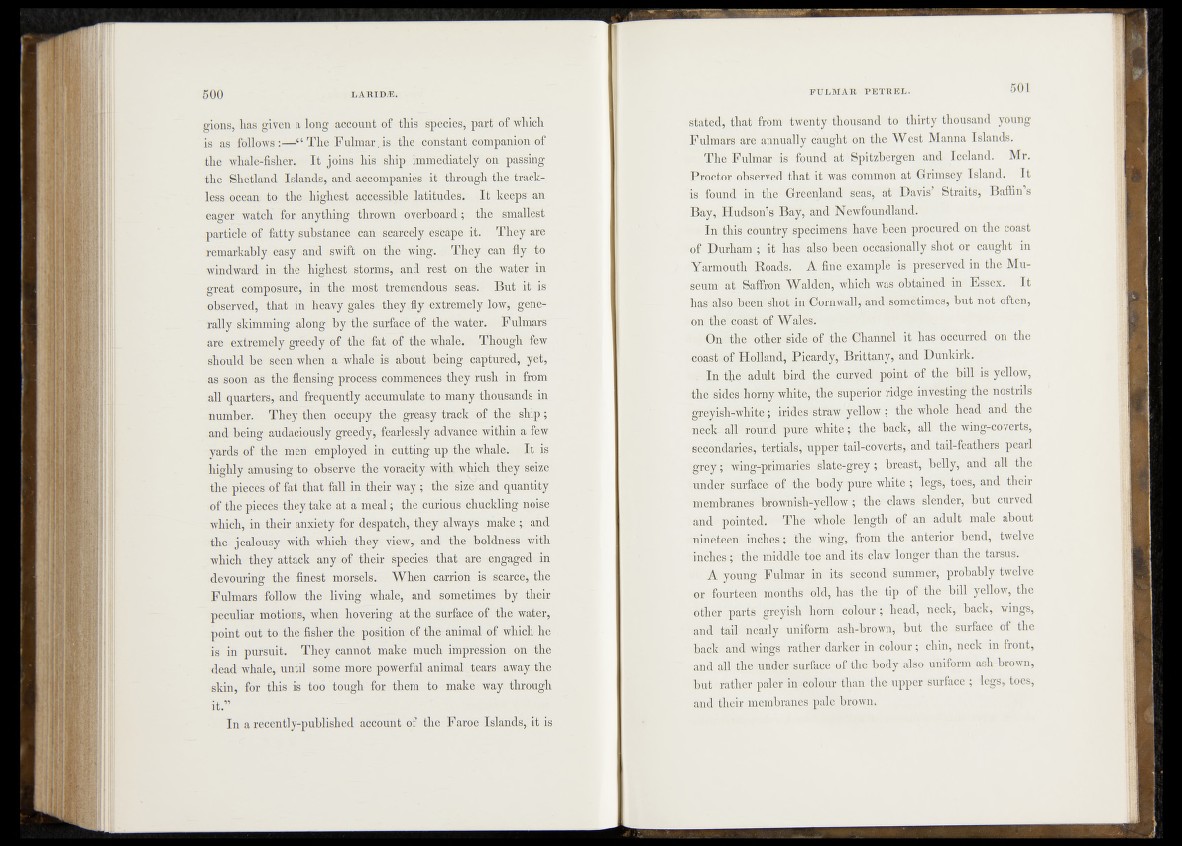
gions, has given a long account of this species, part of which
is as follows:— “ The Fulmar,is the constant companion of
the whale-fisher. I t joins his ship immediately“ on passing
the Shetland Islands, and accompanies if through the trackless
ocean t,Q the highest accessible latitudes. It keeps an
eager- watch for anything thrown overboard; the smallest
particle of fatty substance can scarcely esfc&pe it. They are
remarkably easy and swift on the wing. The ƒ .-can fly to
windward in the highest storms, and rest on the water in
great composure, in the; most tremendous seas. But it is
observed, that in heavy gales' they,fly extremely low, generally
skimming along by the surface of the water. Fulmars
are extremely greedy of the fat of the whale. Though few
should be seen when a whale is about being captured, yet,
as soon as the flensing process commences they rush in from
all quarters, and frequently accumulate to many thousands in
number. They then occupy the greasy track of the ship;
and being audaciously greedy, fearlessly advance within a few
yards of the men employed in cutting up the whale. %kt is
highly amusing to observe the voracity With, which they seize
the pieces of fat that fall in their way ; the size and quantity
of the pieces they take at a meal; the curious chuckling .noise
which, in their anxiety for despatch, they always .make ; and
the jealousy with which they view,- and the boldness with
which they attack any of their species that are-engaged in
devouring the finest morsels. When carrion is,scarce^the
Fulmars follow the living whale, and sometimes by their
peculiar motions, when hovering at the surface of the water,
point out to the fisher the position of the- animal of which he
is in pursuit. They cannot make much impression on the
dead whale, until some more powerful animal .tears away the
skin, for this is tod tough- for them to make way through
it.”
In a recently-published account of the Faroe Islands, it is
stated, that from twenty thousand to thirty thousand young
Fulmars are annually caught on the West Manna Islands.
The Fulmar is found at Spitzbergen and Iceland. Mr.
Proctor observed that it was common at Grimsey Island. It
is found in the Greenland seas, at Davis’ Straits, Baffin s
Bay, Hudson’s Bay, and Newfoundland.
In this country specimens have been procured on the coast
of Durham ; it has also been occasionally shot or caught in
Yarmouth Roads. A fine example is preserved in the Museum
at Saffron Walden, which was obtained in Essex. I t
has also been shot in'Cornwall* and sometimes, but not often,
on,the coast of Walps.
On the other side of .the Channel it has occurred on the
coast .of Holland, Picardy, Brittany, and Dunkirk.
. In the adult bird the curved point of the bill is yellow,
the sides horny white, the superior ridge investing the nostrils
greyish-white; iridcs straw yellow ; the whole head and the
neek- all round pure white; the back, all the wing-coverts,
secondaries, tertials, upper tail-coverts, and tail-feathers pearl
grey; wing-primaries slate-grey; breast, belly, and all the
under surface of ’^he body pure white ; legs, toes, and their
membranes brownish-yellow; the claws slender, but curved
and pointed. The whole length of an adult male about
nineteen inches; the wing, from the anterior bend, twelve
inches:;' the middle toe and its claw longer than the tarsus.
A young Fulmar in its second summer, probably twelve
or fourteen months old, has the tip of the bill yellow, the
other parts greyish horn colour; head, neck, back, wings,
and fail nearly uniform ash-brown, but the surface of the
back and wings rather darker in colour; chin, neck in front,
and all the undPr surface of the body also uniform ash-brown,
but rather paler in colouT than the upper surface ; legs, toes,
and their membranes pale, brown.